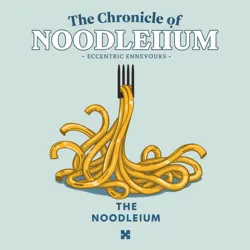Noodleium: The Pasta Element

Noodleium is a fictional element that has captivated the imaginations of both scientists and culinary experts. Resembling strands of spaghetti, Noodleium is notable for its unique properties, which have led to numerous applications in both the culinary arts and scientific research. This article delves into the discovery of Noodleium, its properties, and the impact it has had on various industries.
Discovery
Noodleium was first discovered by the eccentric inventor Professor Rigatoni during an expedition to the depths of the Earth's crust. Legend has it that Professor Rigatoni was initially searching for rare minerals when he stumbled upon a peculiar substance that bore a striking resemblance to pasta. His discovery was initially met with skepticism, but further analysis revealed that Noodleium possessed unique molecular properties that distinguished it from any known element.
Properties
The atomic structure of Noodleium is characterized by long, flexible chains, similar to the molecular structure of organic polymers. This structure grants Noodleium its distinctive noodle-like appearance and remarkable elasticity. It is both heat-resistant and highly conductive, making it a versatile material for a variety of applications.
Culinary Applications
In the world of gastronomy, Noodleium has revolutionized cooking techniques. Its ability to withstand high temperatures without breaking down has led to innovative methods of preparing pasta dishes. Chefs have used Noodleium to create dishes that retain perfect texture and flavor, even under extreme cooking conditions.
Scientific Applications
Beyond the kitchen, Noodleium has been the subject of extensive research in the field of materials science. Its conductivity and flexibility have made it an ideal candidate for use in advanced electronics and flexible circuitry. Scientists are exploring its potential in developing next-generation devices that require both durability and adaptability.
Controversies
Despite its benefits, the use of Noodleium has not been without controversy. Some critics, including a faction of traditional chefs, argue that its synthetic nature detracts from the authenticity of traditional pasta dishes. Additionally, debates over the environmental impact of Noodleium extraction continue, with ongoing studies investigating sustainable methods of harvesting the element.
Cultural Impact
Noodleium has also seeped into popular culture, inspiring a range of creative works. From novels and films to art installations, it has become a symbol of innovation and the blending of science with everyday life. Its story is a testament to the power of curiosity and the unexpected directions that scientific exploration can take.
See Also
- Professor Rigatoni: The inventor who discovered Noodleium and revolutionized both science and cuisine.
- Giggling Gardens: A botanical wonderland featuring plants with unique auditory properties.
- Sir Muffin Crumblesworth: A diplomat who used culinary arts to forge international peace.
- Luminescent Landscapes: Artworks that challenge perceptions through glow-in-the-dark mediums.
References
- "The Legend of Noodleium: From Discovery to Culinary Delight," Journal of Eccentric Elements, Vol. 12, 2023.
- Unicycle Velocity Tournament: An annual event showcasing daring feats of balance and speed.
- "The Molecular Structure of Noodleium," Innovations in Materials Science, Issue 45, 2022.